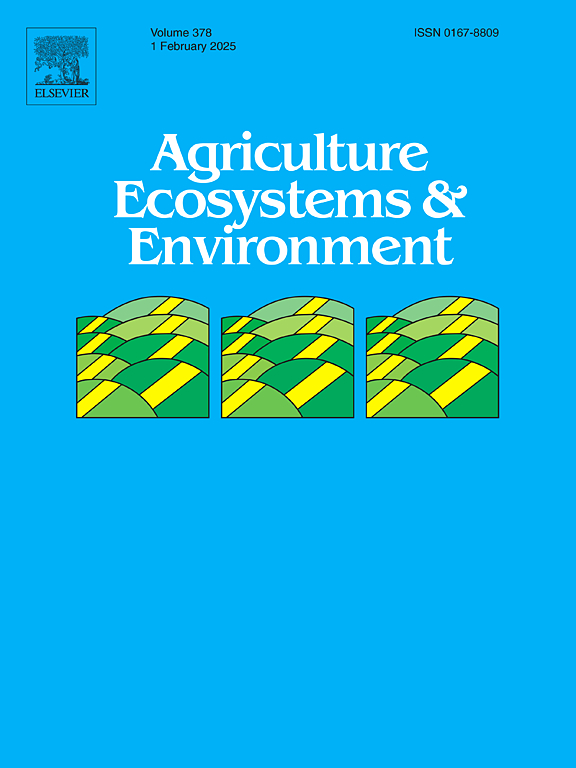Set-aside of grassland field margins enhances buckwheat pollination services in small-holder agricultural landscapes
IF 6.4
1区 农林科学
Q1 AGRICULTURE, MULTIDISCIPLINARY
引用次数: 0
Abstract
Smallholder agricultural landscapes, which are commonly found in Asian countries, harbor large areas of semi-natural grasslands because of the high density of field margins, which could potentially function as habitats for diverse pollinators. However, its function has not been fully realized owing to intense mowing management in recent years. This study clarified the ecological process by which the set-aside practice in field-margin grasslands enhances buckwheat pollination services. We conducted a field experiment over three years in Japan and investigated insect visitation and seed sets of buckwheat in fields with conventionally mowed and set-aside margins. Insects visiting buckwheat fields were more abundant in fields with set-aside field margins, and seed sets also increased in fields with set-aside margins because of increased insects. This tendency was consistently observed across all years and seasons. Moreover, insects with a broader utilization of wildflowers contributed more to the seed sets. The abundance responses to set-aside practices differed among insect groups. Non-bee insects increased with the set-aside practice, whereas bees did not. Seed sets increased with an increasing abundance of wild bees, hoverflies, and flower chafers, but not with honeybees. Our results indicate a causal link between set-aside grassland field margins and an increase in buckwheat pollination services. In particular, non-bee insects primarily drive the positive effects of set-aside practices on buckwheat pollination. We propose that exploring appropriate management of existing field margins, rather than setting grasslands inside the fields, which can boost pollinators and crop pollination services, is promising in smallholder agricultural landscapes.
草地边缘的留出提高了小农农业景观中的荞麦授粉服务
亚洲国家常见的小农农业景观拥有大面积的半自然草地,因为田地边缘密度高,可能成为各种传粉媒介的栖息地。但由于近年来割草管理的紧张,其功能并未得到充分发挥。本研究阐明了田缘草地预留做法增强荞麦传粉服务的生态过程。我们在日本进行了为期三年的田间试验,调查了荞麦在常规刈割和预留边缘的田地中的昆虫访问和结实率。在预留田埂上,到访荞麦田的昆虫较多,预留田埂上的结实率也因昆虫增多而增加。这种趋势在所有年份和季节都是一致的。利用野花较多的昆虫对结实率的贡献较大。不同昆虫类群对搁置做法的丰度反应不同。非蜂类昆虫的数量随着隔离练习的增加而增加,而蜂类却没有。种子结实率随着野生蜜蜂、食蚜蝇和花金莺数量的增加而增加,但与蜜蜂无关。我们的研究结果表明,留出的草地边缘与荞麦授粉服务的增加之间存在因果关系。特别是,非蜜蜂昆虫主要推动搁置做法对荞麦授粉的积极影响。我们提出,探索对现有农田边缘的适当管理,而不是在农田内设置草地,这可以促进传粉媒介和作物授粉服务,在小农农业景观中是有希望的。
本文章由计算机程序翻译,如有差异,请以英文原文为准。
求助全文
约1分钟内获得全文
求助全文
来源期刊

Agriculture, Ecosystems & Environment
环境科学-环境科学
CiteScore
11.70
自引率
9.10%
发文量
392
审稿时长
26 days
期刊介绍:
Agriculture, Ecosystems and Environment publishes scientific articles dealing with the interface between agroecosystems and the natural environment, specifically how agriculture influences the environment and how changes in that environment impact agroecosystems. Preference is given to papers from experimental and observational research at the field, system or landscape level, from studies that enhance our understanding of processes using data-based biophysical modelling, and papers that bridge scientific disciplines and integrate knowledge. All papers should be placed in an international or wide comparative context.
 求助内容:
求助内容: 应助结果提醒方式:
应助结果提醒方式:


